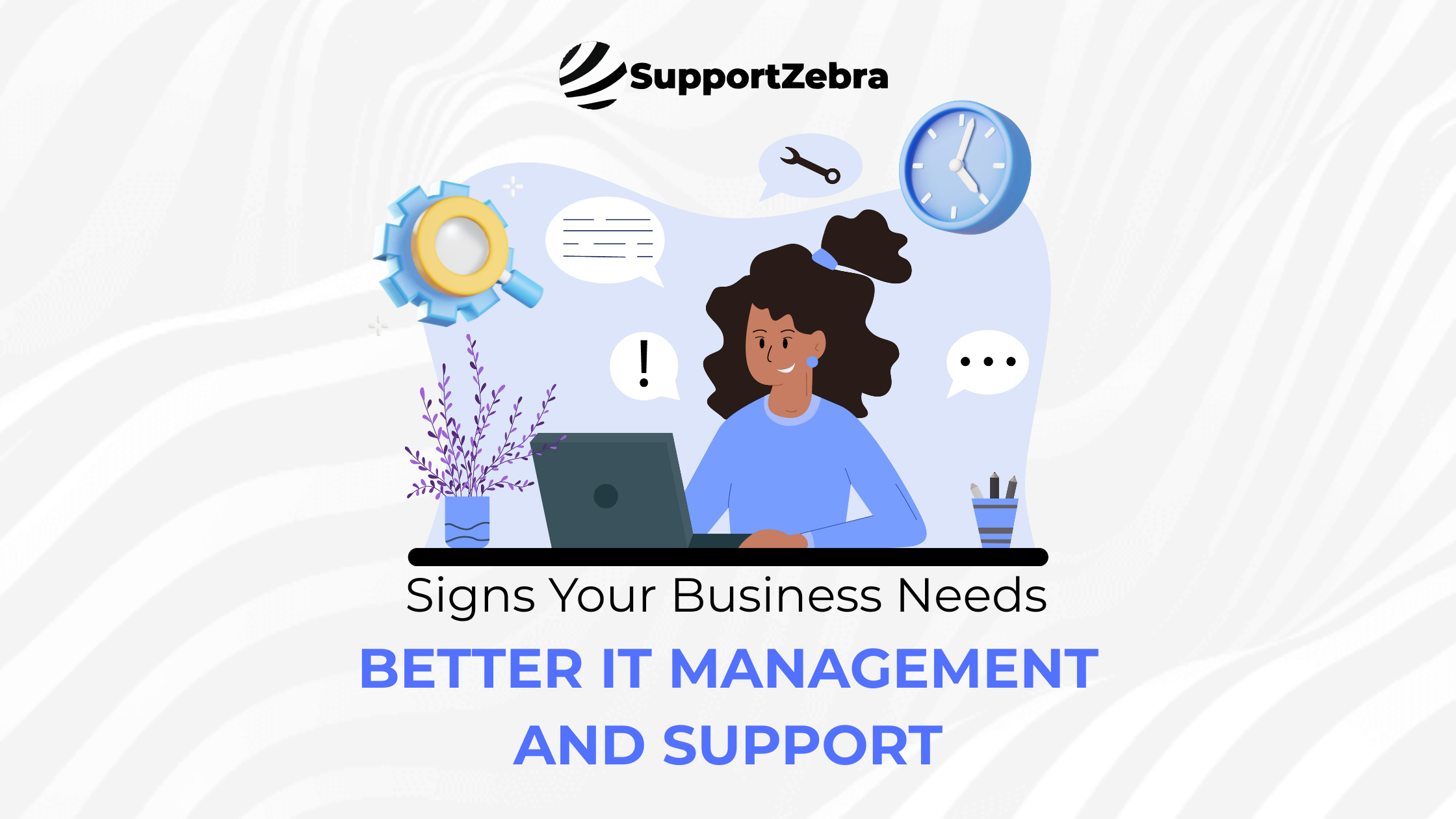When to Rethink Your Current IT Management and Support Strategy
Key Takeaways:
- Recurring IT issues and slow response times are clear signs your current support is no longer practical.
- Outdated systems and frequent security incidents pose a significant risk to your data and operations.
- Poor communication and rising, unpredictable IT costs indicate a lack of strategic oversight.
- Partnering with a proactive IT management provider like SupportZebra can help you boost productivity, enhance security, and scale with confidence.
Your business relies on technology every day, but when IT issues keep piling up, systems slow down, and support feels reactive instead of helpful, frustration builds fast. You may feel like you’re constantly putting out fires, losing time, and risking the loss of valuable data. If these problems go unchecked, they can snowball into serious downtime, unhappy customers, and missed growth opportunities.
The good news? You don’t have to keep settling for “just enough” support. With the right IT management partner, you can regain control, boost efficiency, and focus on what matters: growing your business.
How Can I Tell If My Team Is Wasting Too Much Time on IT Issues?
If your employees are frequently distracted by IT problems, productivity takes a direct hit. Here are some clear indicators that IT issues are consuming too much of your team’s time:
- Staff regularly submit multiple support tickets for the same recurring problems.
- Employees spend more time troubleshooting than focusing on their core responsibilities.
- There is a noticeable drop in output or missed deadlines due to technical glitches.
- Team members express frustration with slow computers, unreliable software, or connectivity issues.
When these patterns become routine, it’s a strong sign your business needs more proactive IT management to keep operations running smoothly.
What Are the Warning Signs of Outdated or Inadequate Technology?
Outdated technology can slow down your business and expose you to unnecessary risks. Watch for these red flags:
- Essential software or hardware is no longer supported by vendors.
- Systems are incompatible with new applications or updates.
- Devices crash frequently or take a long time to boot up.
- Security patches and updates are missed, leaving vulnerabilities unaddressed.
Relying on aging technology not only hampers productivity but also increases the likelihood of security breaches and data loss.
Why Do Frequent Security Incidents Suggest a Need for Better IT Management and Support?
Security threats are evolving rapidly, and businesses must stay ahead to protect sensitive information. If your company experiences any of the following, it’s time to reassess your IT management and support:
- Repeated malware infections, phishing attacks, or data breaches.
- Employees receive suspicious emails or links on a regular basis.
- Lack of clear security policies or inconsistent enforcement.
- No regular security training or awareness programs are in place for staff.
Consistent security incidents suggest that your current IT management lacks the necessary tools and expertise to maintain your business’s security.
What Does Slow Response to IT Problems Reveal About My Current Support?
Timely IT management and support are crucial for minimizing downtime and maintaining productivity. Signs of inadequate support include:
- Long wait times for help desk responses or problem resolution.
- Lack of communication or updates on ticket status.
- Issues remain unresolved for days or weeks.
- No clear escalation process for urgent problems.
If your IT provider or internal team is slow to respond, it can lead to frustration, lost revenue, and a tarnished reputation.
How Do Repeated Downtimes and System Outages Impact My Business?
Downtime can be costly, both in terms of lost productivity and damage to customer trust. Warning signs include:
- Frequent, unplanned system outages disrupt daily operations.
- Regular maintenance windows are poorly communicated or scheduled during business hours.
- No clear disaster recovery or business continuity plan is in place.
- Difficulty accessing critical files or applications during outages.
Consistent downtime suggests your IT infrastructure is not being managed proactively or efficiently.
How Can Technology Improve the Escalation Process?
Modern call centers increasingly rely on technology to streamline escalation management:
- AI and Automation: Automatically route calls based on issue type, customer priority, or agent availability, reducing wait times and misrouting.
- Integrated Communication Platforms: Combine voice, messaging, social media, and video in one interface, enabling agents to access complete customer histories and collaborate internally without switching tools.
- Speech Analytics: Analyze calls in real time to detect escalation triggers and alert supervisors for immediate intervention.
- Escalation Tracking Software: Maintain detailed logs of escalations, generate reports on trends, and support coaching efforts to drive effective outcomes.
These technologies enhance accuracy, speed, and agent empowerment, ultimately improving the customer experience.
Is My Business Growing Too Fast for Our Current IT Capabilities?
Rapid growth is exciting, but it can strain your existing IT resources. Signs your IT can’t keep up include:
- Delays in onboarding new employees due to a lack of equipment or software licenses.
- Difficulty scaling systems to accommodate increased demand.
- Inability to support remote work or new locations seamlessly.
- IT staff are overwhelmed and unable to address all requests in a timely manner.
If your technology can’t support your business’s expansion, you risk stalling growth and missing opportunities.
What Does Poor Communication from IT Providers Indicate?
Effective IT management and support rely on clear, consistent communication. Poor communication can manifest as:
- Lack of transparency about service levels, pricing, or project timelines.
- No regular updates on the status of ongoing issues or projects.
- Difficulty reaching your IT provider when you need help.
- No feedback or reporting on system health or performance is provided.
When communication breaks down, problems go unresolved, and your business is left in the dark.
How Can I Tell If My IT Costs Are Out of Control?
Unpredictable or escalating IT expenses can signal inefficient management. Look for these warning signs:
- Frequent emergency repair bills or unplanned purchases.
- No clear IT budget or cost forecasting is available.
- Paying for unused or redundant software and services.
- Lack of visibility into where IT funds are being spent.
Effective IT management offers transparency, cost control, and strategic planning to optimize your technology investment.
What Steps Should I Take If I Recognize These Signs?
If you notice any of the above issues, it’s time to consider upgrading your IT management and support. Here’s what you can do:
- Conduct a comprehensive IT assessment to identify weaknesses.
- Consult with a reputable managed service provider (MSP) for expert guidance and support.
- Implement proactive monitoring and regular maintenance.
- Invest in staff training and security awareness programs to enhance overall security and safety.
- Establish clear communication channels and service level agreements (SLAs).
Taking these steps will help you build a more resilient, efficient, and secure IT environment for your business.
Simplify IT Management and Support with a Trusted Outsourcing Partner

Recognizing the signs that your business needs better IT management and support is the first step toward a more productive, secure, and scalable organization. Don’t wait for a crisis. Proactive IT management can save you time, money, and stress while positioning your business for long-term success.
Struggling with slow systems, recurring tech issues, or growing IT demands? SupportZebra provides reliable and scalable IT management and support solutions tailored to your business needs. Let our expert team handle the tech so you can focus on what you do best: growing your business. Reach out today and make IT stress-free.

